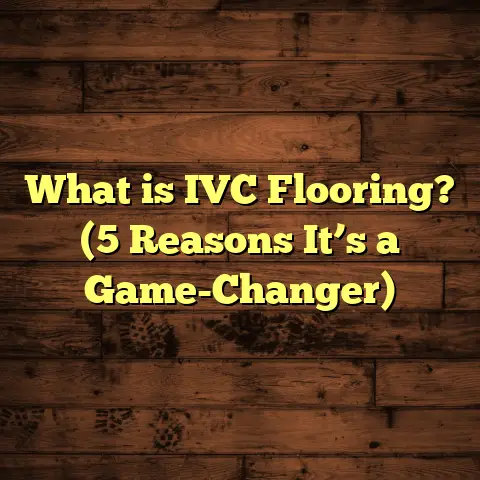What is Cheap Tile or Vinyl Flooring? (5 Budget Tips Explained)
I remember the first time I had to pick flooring on a tight budget. The excitement quickly turned into frustration because I didn’t want to sacrifice style or durability, yet I had to keep costs low. If you’ve ever been there, you know how tricky it can be to find flooring that looks good, lasts long, and doesn’t break the bank. That’s why I want to share some insights about cheap tile and vinyl flooring, based on years of experience working with homeowners and contractors alike.
Choosing the right flooring when your budget is limited can sometimes feel like a puzzle. Do you go for cheaper materials that might not last? Or splurge on something expensive and hope it fits your budget? Over time, I’ve realized that understanding what cheap tile or vinyl flooring really means and how to navigate your options can make all the difference.
What is Cheap Tile or Vinyl Flooring?
When people talk about cheap tile or vinyl flooring, they usually mean options that deliver the look and function of more expensive materials but at a fraction of the cost. But “cheap” doesn’t have to imply low quality or poor appearance. Let me explain.
Cheap tile flooring generally refers to ceramic or porcelain tiles that are budget-friendly yet still offer decent durability and style. These tiles might not have the intricate designs of high-end porcelain or natural stone tiles, but they can mimic those looks surprisingly well.
Vinyl flooring is a synthetic material made primarily from PVC (polyvinyl chloride). It comes in sheets, planks, or tiles and is known for being one of the most affordable and versatile flooring choices. Vinyl can imitate wood, stone, or ceramic tile convincingly, especially with modern printing and embossing technologies.
Both types are popular for budget-conscious projects because they balance cost, durability, and aesthetics effectively.
Why Choose Tile or Vinyl When Budget is Tight?
From my experience, many homeowners lean toward hardwood or natural stone when dreaming about new floors. But those options can easily push budgets beyond what’s comfortable.
Tile and vinyl offer:
- Durability: Both handle moisture well, making them ideal for kitchens, bathrooms, and basements.
- Variety: You get tons of design options without spending a fortune.
- Ease of maintenance: They’re relatively simple to clean and maintain.
- Longevity: Good quality vinyl and ceramic tiles can last 10-20 years with proper care.
But here’s the catch — not all cheap tile or vinyl floors are created equal. Some low-cost options degrade quickly or look obviously cheap. That leads to regret and replacement costs down the line.
So, how do you get the best value? Here are five budget tips I’ve learned over many projects:
1. Choose the Right Type of Tile or Vinyl for Your Space
Picking the right product upfront saves both money and headaches later.
Ceramic vs Porcelain Tile
Ceramic tiles are generally less expensive than porcelain. They’re made from red or white clay and fired at lower temperatures. While ceramic can be quite durable for walls and light foot traffic floors, porcelain tiles are denser, harder, and more water-resistant — perfect for high-traffic areas.
When working with clients, I recommend ceramic tiles for living rooms or areas with moderate use but go porcelain for kitchens and bathrooms.
One time, I worked on a bathroom renovation where the client wanted a natural stone look but was worried about cost. We went with porcelain tiles that had a matte finish resembling slate. The price was about $3.50 per square foot, compared to over $12 for real stone. The client was thrilled with how it looked and how easy it was to maintain.
Vinyl Planks vs Vinyl Sheets
Vinyl sheets tend to be cheaper per square foot than vinyl planks but can be trickier to install well due to seams. Vinyl planks are easier for DIYers because they click together like laminate flooring. They also tend to look more like wood or stone.
If you’re on a tight budget but want a wood-like feel in your living room, vinyl planks are often worth the slightly higher price.
I once installed vinyl sheet flooring in a rental property’s kitchen because it was extremely affordable — around $1.75 per square foot. However, the seams showed after a couple of years because of poor subfloor preparation. Since then, I’ve advised clients to invest a little more in vinyl planks if they want longer-lasting results in highly used spaces.
2. Opt for Standard Sizes and Simple Patterns
Custom shapes or intricate patterns drive up tile costs significantly. Manufacturers charge more for specialty cuts or unique designs because they waste more raw material and require extra labor.
When budgeting a project, I tell people to stick with:
- 12×12 or 12×24-inch tiles (these sizes are common and offer a good balance of coverage and style)
- Simple geometric patterns like straight lay or grid patterns
- Basic colors like grays, whites, or beige that blend well with many decor styles
This approach can save anywhere from 15% to 30% compared to fancy patterns or oversized tiles.
I’ve seen many homeowners get tempted by hexagon tiles or intricate mosaic patterns only to find their budgets balloon once installation costs are factored in. Simple rectangular tiles arranged in a running bond pattern often give a modern look without the extra expense.
3. Take Advantage of Clearance Sales and Overstock Deals
Here’s a little secret from my contractor days: many flooring suppliers have clearance sections where you can find high-quality tile or vinyl at deeply discounted prices.
Sometimes these are discontinued lines, slightly imperfect batches, or overstocked inventory. But if you inspect carefully and don’t mind mixing batches for texture variety, this can massively cut costs.
For example, I once sourced 500 square feet of porcelain tile for $1.50/sq ft while the regular price was $4.00/sq ft. That saved my client over $1,200!
I keep an eye on local warehouse sales and distributor closeouts regularly because good discounts pop up unexpectedly. You just have to be ready to act fast when you see a deal that fits your project needs.
How To Spot Good Clearance Flooring Deals
- Check for minor surface blemishes but avoid structural cracks.
- Confirm return policies in case you order too much.
- Consider mixing clearance stock with standard stock if color variation is acceptable.
- Verify that the style suits your home’s overall aesthetic so you don’t end up stuck with something you don’t love.
4. Consider DIY Installation But Know When to Hire Pros
Installing vinyl flooring yourself is often possible if you have patience and follow instructions closely. Vinyl planks with click-lock systems are especially DIY-friendly. You can save hundreds in labor costs by doing this yourself.
Tile installation is trickier and more labor-intensive. Improper installation can lead to cracked tiles or uneven floors that need fixing later — costing more overall.
If your budget is tight but your floor area is small (like a bathroom), consider hiring a pro just for the tile work. For bigger spaces or vinyl installs, DIY can be a real money saver.
My Experience With DIY Vinyl Installation
I helped my sister install vinyl plank flooring in her basement rec room. We did it over a weekend using click-lock planks she bought on sale for $2.50 per square foot. The total cost including tools was under $1,000 for about 400 sq ft.
It wasn’t perfect—there were minor gaps in some places—but overall it looked great and held up well after two years.
When To Avoid DIY
If you’re dealing with uneven subfloors, moisture issues, complicated cuts (around cabinets or stairs), or large tiled areas requiring grout work — hiring a professional ensures you don’t waste money fixing mistakes later.
5. Calculate Waste and Order Smartly
One costly mistake I see often is underestimating how much material you need. Tiles often come in boxes covering a fixed area (usually about 11 sq ft per box). Vinyl rolls come in fixed widths and lengths too.
You should add a waste factor:
- About 10% extra for vinyl flooring to cover trimming and mistakes
- Around 15% extra for tile installations because cutting around corners and odd spaces creates more waste
Using tools like FloorTally helps me input room dimensions and get accurate estimates including waste factors so I don’t overbuy or underbuy.
I once worked on a kitchen renovation where the client ordered exactly 200 sq ft of tile thinking it would be enough for their 190 sq ft floor space. Because we didn’t add waste allowance, we had to rush-order additional tiles urgently at full price — adding an unexpected $150 cost.
Breaking Down Costs: What You Can Expect To Pay
Here’s some detailed pricing data based on projects I’ve done in various cities across the US over the last five years:
| Flooring Type | Material Cost per Sq Ft | Labor Cost per Sq Ft | Total Cost per Sq Ft | Typical Lifespan |
|---|---|---|---|---|
| Ceramic Tile | $1.50 – $3 | $3 – $5 | $4.50 – $8 | 20+ years |
| Porcelain Tile | $2 – $5 | $4 – $6 | $6 – $11 | 25+ years |
| Vinyl Sheet | $0.75 – $2 | $1 – $3 | $1.75 – $5 | 10-15 years |
| Vinyl Plank | $1 – $3 | $2 – $4 | $3 – $7 | 15-20 years |
Labor costs vary widely depending on region and complexity of installation. For instance:
- Installing tile on a concrete slab is usually easier than over plywood subfloors.
- Cutting around fixtures increases labor time.
- Large format tile installation demands more skill and tends to cost more.
Maintenance Tips For Cheap Tile And Vinyl Flooring
To get the most out of your budget-friendly flooring investment, proper care matters:
Tile Flooring Care
- Sweep or vacuum regularly to remove grit that can scratch surface.
- Mop with mild detergent; avoid harsh chemicals that degrade grout.
- Seal grout lines every 1-2 years to prevent staining.
- Fix any cracked tiles immediately to avoid moisture damage underneath.
Vinyl Flooring Care
- Avoid abrasive scrubbing pads; use soft cloths or mops.
- Clean spills promptly; standing water can damage subfloor.
- Use floor protectors under furniture legs.
- Avoid wax-based cleaners unless manufacturer approves.
When done right, these floors stay attractive for years without costly repairs.
Real Case Study: Budget Kitchen Flooring Makeover
I worked with a young couple who bought an older home with worn-out linoleum floors in their kitchen and dining space. They had about $1,800 budgeted strictly for new flooring material + installation.
After assessing options:
- We selected ceramic tile at around $2 per sq ft.
- Chose a classic white subway tile pattern laid in straight lines.
- Hired local installer who quoted competitive labor rates ($3 per sq ft).
The total bill came close to $1,800 but gave them durable floors resistant to kitchen spills and foot traffic.
They told me later how happy they were — no regrets about not going for hardwood which would have cost triple their budget.
Common Myths About Cheap Tile & Vinyl Flooring
I’ve heard many misconceptions over the years:
- “Cheap means ugly” — Not true if you pick wisely.
- “Vinyl is only for rentals” — Luxury vinyl planks now rival hardwood looks.
- “Tile is cold and uncomfortable” — Area rugs solve that easily.
- “Installation costs always ruin the budget” — DIY options exist if you’re willing.
Understanding facts vs myths helps make better decisions without fear.
How To Spot Quality In Budget Flooring Products
Even cheap tile or vinyl can be good quality if you know what markers to look for:
For Tile
- Weight: Heavier usually means denser porcelain versus lightweight ceramic.
- PEI rating (Porcelain Enamel Institute): Look for rating 3+ for residential floor use.
- Water absorption rate: Porcelain absorbs less than 0.5%, ceramic higher.
For Vinyl
- Thickness: Thicker wear layers (20 mil +) last longer.
- Warranty: Longer manufacturer warranty signals confidence.
- Embossing: Better embossing means more realistic textures like wood grain.
Ask suppliers questions — good ones welcome inquiries about product specs.
Design Ideas That Don’t Break The Bank
Good design isn’t only about expensive materials; clever choices make cheap floors look stylish:
- Use contrasting grout color with plain tiles for visual interest.
- Mix wood-look vinyl planks with neutral paint for cozy vibe.
- Lay rectangular tiles in herringbone pattern (still affordable) for style boost.
When helping clients pick designs within budget, I always encourage creativity over cost alone.
Final Thoughts On Cheap Tile Or Vinyl Flooring
Finding budget-friendly flooring that works well isn’t impossible if you know what you’re looking for. Cheap tile or vinyl flooring can be durable, attractive solutions when selected carefully based on room needs and your style preferences.
Remember my five tips:
- Pick the right type based on use.
- Stick with standard sizes/patterns.
- Hunt clearance sales smartly.
- Do it yourself cautiously.
- Add waste allowance when ordering materials.
If you follow these steps, your floors won’t just save money — they’ll add value and comfort to your home for years.
Feel free to ask if you want help planning your next flooring project! I’m always happy to share what I’ve learned along the way.





